| dc.description.abstract | This report summarizes the results from a series of experiments carried out in 7 new dilations rigs measuring autogenous deformation in concrete. The intention was to find a relation between autogenous deformation and relative humidity in three different mixes with three different binders. Another objective was to compare and verify the measurements of the new test rigs with corresponding samples tested according to SINTEF’s standardized shrinkage test method, which is described in KS 14-05-04-117. Three different mixtures were used; one with Portland cement only (Portland cement, class CEM I 52,5 N), one with the same Portland cement and 5,2 % silica by cement weight and the third with the Portland cement and 50 % fly ash by cement weight. Three specimens (100×100×500 mm) were cast from each mixture; two in the new dilation rigs and one for SINTEF’s standard shrinkage test method. In addition, a specimen for measuring relative humidity (% RH) was cast from each mixture. Data from the measurements of deformation and relative humidity were collected in order to map the relation between autogenous deformation and relative humidity at certain concrete ages. Autogenous deformation was measured with LVDTs (electrical transformers commonly used for measuring linear displacement) in the new Dilation Rigs. To measure relative humidity, a VAISALA Concrete Humidity Measurement System was used. All tests were performed in temperature conditioned environments, and a JULABO FP33 was used to regulate the temperature development in the concrete. Deformation of the reference specimens, were measured by the SINTEF standard shrinkage test method. Some expected results of the concrete were confirmed during the experiments. Fly ash retards the heat development in the concrete, and further the hardening process. The self-desiccation of the concrete slows down, and seems to result in a higher relative humidity for a longer period. Considering the results from the new rigs towards | |
